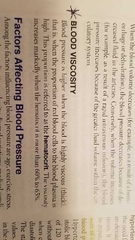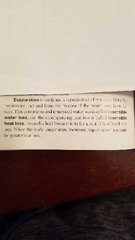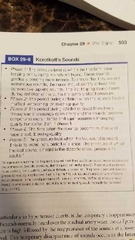![]()
![]()
![]()
Use LEFT and RIGHT arrow keys to navigate between flashcards;
Use UP and DOWN arrow keys to flip the card;
H to show hint;
A reads text to speech;
71 Cards in this Set
- Front
- Back
- 3rd side (hint)
|
Apical radial pulse |
Measurenent of the apical and radial at the same time |
|
|
|
Apical pulse |
A central pulse located at the apec of the heart |
|
|
|
Afebrile |
Without fever |
|
|
|
Apena |
Absence of breathing |
|
|
|
Arterial blood pressure |
Measure of the pressure exerted by the blood as it flows through the arteries |
|
|
|
Arrhythmia |
A pulse with irregular rhythm |
|
|
|
Arteriosclerosis |
When the elastic and muscular tissue of the arteries are replaced with fibrous tissue , |
|
|
|
Ataxic respiration |
Abnormal pattern of breathing characterized by complete irregularity of breathing with irregular pauses |
|
|
|
Auscultatory gap |
Temporary disappearance of sounds normally heard over the brachial artery when the cuff pressure is high Followed by sound at a lower level |
|
|
|
Auscultation |
Process of listening to sounds produced in the body You listen a stethoscope to listen |
|
|
|
BMR What does it stand for and what's the definition |
Rate of energy utilization in the body required to maintain essential activities such as breathing |
Temperature |
|
|
Core temperature |
Temperature of deep tissues of the body such as abdominal cavity and pelvic cavity |
|
|
|
Surface temperature |
Temp of skin |
|
|
|
Bradycardia Tachycardia |
•A heart rate less than 60 •Fast heart rate over 100 beats per min |
|
|
|
Bradypnea |
Abnormally slow respirations |
|
|
|
Eupnea |
Breathing at a normal in rate and depth |
|
|
|
Tachypnea |
Abnormally fast respirations |
|
|
|
Cardiac output |
The volume of blood pumped into the arteries by the heart and equals the result of stroke volume times heart rate per minute |
|
|
|
Cheyne- stokes respirations |
(Rhythm) Abnormal pattern of breathing characterized by progressively deeper and sometimes faster breathing followed by a gradual decrease that results in a temporary stop in breathing |
|
|
|
Chronic vs acute pain |
ACUTE: when pain only lasts through the expected recovery period Mild to severe CHRONIC: persistent pain which is prolonged , usually recurring or lasts 3 months or more |
|
|
|
Compliance |
❤ The arteries and their ability to contact and expand |
|
|
|
Conduction |
Transfer of heat from one molecule to a molecule of lower temperature |
Body temp |
|
|
Convection |
Dispersion of heat by air currents Warm air rises and is replaced with cooler air |
|
|
|
Costal breathing |
( thoracic) Observed by the movement of the chest upward and out |
|
|
|
Diaphragmatic breathing |
Abdominal Contraction and relaxation of the diaphragm and is observed by the movement of the abdomen |
|
|
|
Diastole |
The phase of the heart beat when the heart muscle relaxes and allows the chambers to fill with blood |
|
|
|
Diastolic pressure |
Pressure when the ventricles are at rest |
|
|
|
Diurnal |
Time Variation of temperature that occurs throughout the day |
|
|
|
Dorsalis pedis |
1 of 9 ways to measure pulse On top of foot Used to Determines circulation to the foot |
|
|
|
Dyspnea |
(Ease or effort) Difficult and labored breathing during which the individual has a persistent unsatisfied need for air and feels distressed |
|
|
|
Dysrhythmia |
Same as arrhythmia A pulse with irregular rhythm |
|
|
|
Eupnea |
Breathing that is normal in rate and depth |
|
|
|
Flow sheet pg 226 |
Documentation Assessment criteria in a particular format such as human needs or functional health patterns |
|
|
|
Graphic sheet/ record Pg 231 |
Typically indicates body temperature, pulse, respiratory rate, blood pressure, weight and sometimes more like activity, bowel movement etc |
|
|
|
Heat exhaustion pg 479 |
Result of excess heat and dehydration Signs: include paleness, dizziness, nausea, vomiting, fainting, moderate increase temp |
|
|
|
Heat stroke pg 480 |
Generally person has been exercising in hot weather they have warm flushed skin, often do not sweat, usually have a temperature of 106 or higher may be delirious or unconscious |
|
|
|
Hematocrit pg 500 |

|
|
|
|
_______ of the arteries is their ability to contact and expand |
Compliance |
|
|
|
Hematocrit |
When the proportion of red blood cells to the blood plasma is high |
|
|
|
Hyperthermia |
Means fever |
|
|
|
Hyperpyrexia |
A very high fever |
|
|
|
Hypothermia |
When core body temp is below the lower limit of normal |
|
|
|
Hyperventilation |
A very deep raid respiration |
|
|
|
Hypoventilation |
A very shallow respiration |
|
|
|
1. Hypertension 2. Hypotension |
1. Above normal blood pressure 2. Below normal |
|
|
|
Orthostatic hypotension |
BP that decreases when the client sits or stands |
|
|
|
Insensible water loss and heat loss |

|
|
|
|
Intermittent fever |
Body temp alternates at regular intervals between periods of fever and periods of normal temp |
|
|
|
Korotkoff's sounds |

|
|
|
|
NSAID |
Non steroidal anti inflammatory drugs Ex ibuprofen |
|
|
|
Normotensive |
Having a normal blood pressure |
|
|
|
Orthopnea |
Ability to breath only in upright position |
|
|
|
Pain threshold |
The least amount of stimuli that is needed for a person to label a sensation as pain |
|
|
|
Patient controlled analgesia |
Interactive method of pain management that permits patient to self administer doses of analgesics |
|
|
|
Perpheral |
A pulse away from heart Ex foot |
|
|
|
PMI Point of maximal impulse |
Also called apical pulse Central pulse that is located at the apec of heart |
|
|
|
Polypnea |
Abnormal fast respirations |
|
|
|
Pulse deficit |
Difference between apical and radial pulse |
|
|
|
Pulse oximeter |
Device that estimates arterial blood oxygen saturation goes on patients finger |
|
|
|
Pulse pressure |
The difference between diastolic and systolic pressure |
|
|
|
Pulse volume |
Pulse Strength |
|
|
|
Pyrexia |
Body temp above usual range |
|
|
|
Radiation |
Transfer of heat from 1 surface to another without contact |
|
|
|
Respiratory quality or character |
Refers to the aspect of breathing that are different from normal , effortless breathing, includes the amount of effort exerted to breath and the sounds produced by breathing |
|
|
|
Respiratory rhythm |
Refers to the regularity of expirations and inspirations |
|
|
|
Saturation of peripheral oxygen |
Value is the % of all hemoglobin binding sites that are occupied by oxygen |
|
|
|
Hypoxemia |
Low oxygen saturation |
|
|
|
Systolic pressure |
Pressure of blood as a result of contraction of ventricles |
|
|
|
1. Vasoconstriction 2. Vasodilation |
1. Constricted blood vessel 2. An increase in the diameter of blood vessels |
|
|
|
Viscous |
Thick |
|
|
|
Ventilation |
The movement of air in and out of the lungs .....inhale / exhale |
|

